Ibike Korea People-to-People Program
 Photo essay: Gyeongju Tour
Photo essay: Gyeongju Tour
Points of Interest: A bounty of national treasures: Tombs, temples, folk village, national museum
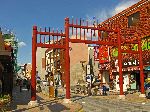

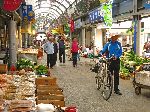 Gyeongju has many things to like: Part of the downtown started with narrow
streets and these have been put on a sever "traffic-diet" to further deter
driving in the neighborhood and make the
environment more pedestrian friendly.
Gyeongju has many things to like: Part of the downtown started with narrow
streets and these have been put on a sever "traffic-diet" to further deter
driving in the neighborhood and make the
environment more pedestrian friendly.The central covered market is spacious, light and have a wide variety of interesting products to muse about.
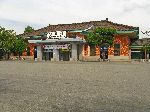
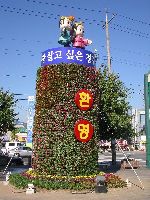
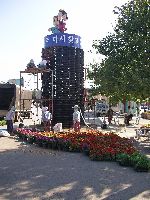 Workers prepare
to place live flowers on the "center piece" in front of the railroad station
(left).
The structure is constructed with a drip irrigation system that goes to each
boxes so that the plants can be easily watered. The finished product is on the
right.
Workers prepare
to place live flowers on the "center piece" in front of the railroad station
(left).
The structure is constructed with a drip irrigation system that goes to each
boxes so that the plants can be easily watered. The finished product is on the
right.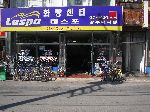
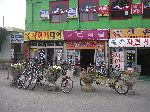 Because of protective
tariffs many bikes in Korea are domestically manufactures. Even "low cost"
imported Chinese bicycles are relatively expensive. The domestic bicycle industry produces
a little over a half million units a year (2003), but is expected to decline in
the future. (By comparison, the domestic
automobile industry produces over three million units a year (2003).) The lower
picture features rental bikes, including a tandem (bicycle for two), which are
very popular with young couples on the weekends. For more on
cycling see
www.ibike.org/engineering\korea\index.htm.
Because of protective
tariffs many bikes in Korea are domestically manufactures. Even "low cost"
imported Chinese bicycles are relatively expensive. The domestic bicycle industry produces
a little over a half million units a year (2003), but is expected to decline in
the future. (By comparison, the domestic
automobile industry produces over three million units a year (2003).) The lower
picture features rental bikes, including a tandem (bicycle for two), which are
very popular with young couples on the weekends. For more on
cycling see
www.ibike.org/engineering\korea\index.htm.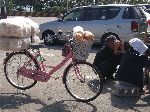
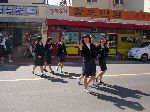
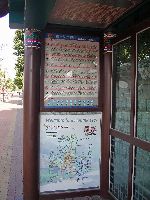
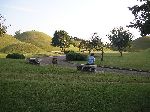
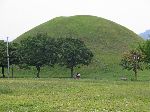 Daereungwon Tomb Park: There are 23
large tombs here from the Kim Clan, reflecting the power and wealth of the royal
family of the Silla Dynasty. Each tomb has a story. One of the
engaging aspects of Korea is all along the road are signs and monuments with
legends and history spanning more than 2000 years.
Daereungwon Tomb Park: There are 23
large tombs here from the Kim Clan, reflecting the power and wealth of the royal
family of the Silla Dynasty. Each tomb has a story. One of the
engaging aspects of Korea is all along the road are signs and monuments with
legends and history spanning more than 2000 years.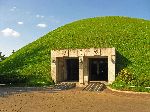
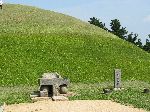 The
only tomb that is prepared for tours is Cheonmachong (Flying Horse Tomb), Silla
Kingdom, 5th or 6th century (left). No one sure who is buried here. 11,500
artifacts excavated.
The
only tomb that is prepared for tours is Cheonmachong (Flying Horse Tomb), Silla
Kingdom, 5th or 6th century (left). No one sure who is buried here. 11,500
artifacts excavated.Other artifacts in the park include monuments and tables at the base of some tombs for offering.
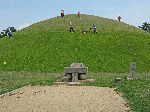 For
those who wonder how the appearance of the tombs is maintained, they are hand
mowed by three teams; one person guides the lawn mower, one person pulls it with
a rope and one person hold another rope tied to the lawn mower to prevent it
from sliding down the hill. Each time, after a team circles the mound once
they are relieve by a second team, who they then relieve after they make a full
tour around the hill.
For
those who wonder how the appearance of the tombs is maintained, they are hand
mowed by three teams; one person guides the lawn mower, one person pulls it with
a rope and one person hold another rope tied to the lawn mower to prevent it
from sliding down the hill. Each time, after a team circles the mound once
they are relieve by a second team, who they then relieve after they make a full
tour around the hill.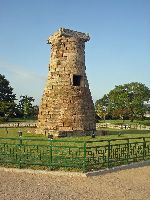
 Cheomseongdae Observatory,
established by Queen Seondeok, is believe to be the oldest in the East. Among the fascination features are: the windows in the tower are
oriented perfectly north-south-east-west and the total number of blocks used to
construct the shell of the tower is the same as the number of days in a year on
the calendar of the time. The length of the top stone is half that of the
stylobate stone.
Cheomseongdae Observatory,
established by Queen Seondeok, is believe to be the oldest in the East. Among the fascination features are: the windows in the tower are
oriented perfectly north-south-east-west and the total number of blocks used to
construct the shell of the tower is the same as the number of days in a year on
the calendar of the time. The length of the top stone is half that of the
stylobate stone.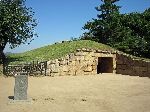
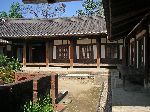
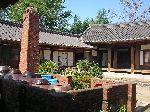



 Our
timing was fortunate enough to be invited to a traditional wedding ceremony:
The bride is carried in a chamber to the wedding (far left), while the groom
waits for the bride (left). As part of exchanging their vows, they
bow deeply to each
other (right). The table is covered with fresh Korean fruit.
After completing the ceremony they stand as husband and wife (far right)
Our
timing was fortunate enough to be invited to a traditional wedding ceremony:
The bride is carried in a chamber to the wedding (far left), while the groom
waits for the bride (left). As part of exchanging their vows, they
bow deeply to each
other (right). The table is covered with fresh Korean fruit.
After completing the ceremony they stand as husband and wife (far right)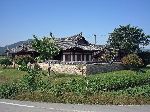
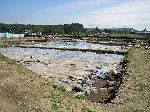
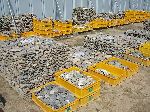
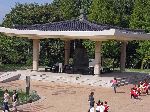

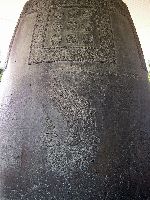
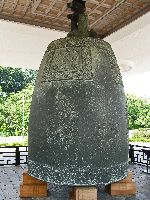 The
hollow tube, which is believed to control the tone, the kneeling apsaras or
heavenly maidens, the four panels, each containing nine nipple-like protrusions,
and the lotus and grass designs are all typical of bells of the Unified Shilla
period. Gyeongju National Museum
The
hollow tube, which is believed to control the tone, the kneeling apsaras or
heavenly maidens, the four panels, each containing nine nipple-like protrusions,
and the lotus and grass designs are all typical of bells of the Unified Shilla
period. Gyeongju National Museum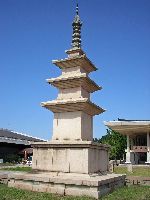
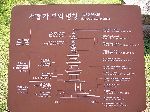 This
pagoda, on the grounds of the Gyeongju National Museum was built in 634, out of
andesite cut like brick. It was probably seven or nine stories at the time.
It was destroyed by the Japanese and rebuilt as a three story pagoda. A visit to
the museum is enhanced by multilingual descriptions of objects and diagrams of
the elements of objects, like the Names of Stone Stupa at the right.
This
pagoda, on the grounds of the Gyeongju National Museum was built in 634, out of
andesite cut like brick. It was probably seven or nine stories at the time.
It was destroyed by the Japanese and rebuilt as a three story pagoda. A visit to
the museum is enhanced by multilingual descriptions of objects and diagrams of
the elements of objects, like the Names of Stone Stupa at the right.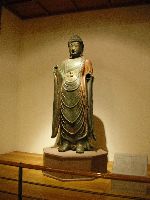

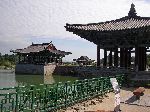
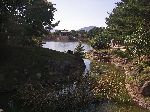 Imhaejeon Palace Site: The
palace was built in the reign of King Munmu who unified the Three Kingdoms.
Anapji Pond (right) is a man-made pond. Since the edges of the pool are
curved, the whole pond can't be seen from any one place. It is said that
the pond was created so as to make a small pond look like a wide sea.
Imhaejeon Palace Site: The
palace was built in the reign of King Munmu who unified the Three Kingdoms.
Anapji Pond (right) is a man-made pond. Since the edges of the pool are
curved, the whole pond can't be seen from any one place. It is said that
the pond was created so as to make a small pond look like a wide sea.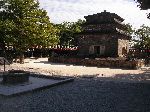
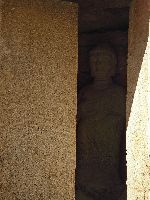 Bunhwangsa Temple: The temple was
built in 634 and it is known as one of the seven best temples of the Shilla
Dynasty. The stone well (lower left corner of upper photo) is octagonal on the
outside, symbolizing the eight rightous teaching of Buddha, and cylindrical
inside, representing the truth of One Buddha. It is still used.
There is a legend that emissaries from Tang China visited Shilla in 795.
They changed three dragons who had been protecting the country into small fish
and took them to China. The next day, two women came to the king and
identified themselves as the wives of two dragons. They asked the king to
retrieve a dragon in the Bunhwangsa well and their husbands whom the emissaries
took. The king immediately sent his men to bring back the dragons and let
them live in the well, from where they protect the country.
Bunhwangsa Temple: The temple was
built in 634 and it is known as one of the seven best temples of the Shilla
Dynasty. The stone well (lower left corner of upper photo) is octagonal on the
outside, symbolizing the eight rightous teaching of Buddha, and cylindrical
inside, representing the truth of One Buddha. It is still used.
There is a legend that emissaries from Tang China visited Shilla in 795.
They changed three dragons who had been protecting the country into small fish
and took them to China. The next day, two women came to the king and
identified themselves as the wives of two dragons. They asked the king to
retrieve a dragon in the Bunhwangsa well and their husbands whom the emissaries
took. The king immediately sent his men to bring back the dragons and let
them live in the well, from where they protect the country.
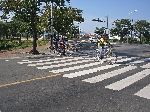
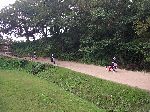 A common weekend activity
is to rent bike with a group of friends and tour the city, or go for a more
rural bike tour. Here a group of young
women (left) and nuns (left) are taking a bike tour of the cultural sites in Gyeongju.
A common weekend activity
is to rent bike with a group of friends and tour the city, or go for a more
rural bike tour. Here a group of young
women (left) and nuns (left) are taking a bike tour of the cultural sites in Gyeongju.
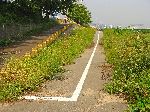
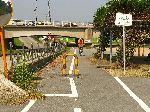 For the more
ambitious, there is a series of paths and sidewalks, or you can brave the roads,
that will get you out to Bomun Tourist Area and Pulguksa, one of the major temples in the country, and
the royal temple during the Shilla Dynasty. Unfortunately not all of the bicycle
facilities are well designed or maintained, but they would get you there.
For the more
ambitious, there is a series of paths and sidewalks, or you can brave the roads,
that will get you out to Bomun Tourist Area and Pulguksa, one of the major temples in the country, and
the royal temple during the Shilla Dynasty. Unfortunately not all of the bicycle
facilities are well designed or maintained, but they would get you there.
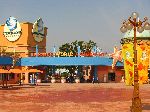 Bomun
is a very purposeful built environment. There are many hotels, a lake,
lakeshore walks, rest areas, public art, golf courses, go-carts and amusement
parts.
Bomun
is a very purposeful built environment. There are many hotels, a lake,
lakeshore walks, rest areas, public art, golf courses, go-carts and amusement
parts.
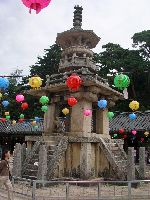
There are two pagodas, Dabotap and Seokgatap which are connected to the sad legend about Asadal (the great stone mason who built the pagodas) and Asanyeo (an his wife). The pagodas took much longer that expected to construct. After waiting in anguish for her husband, Asanyeo undertook the arduous journey across the country to find. Being a woman she was barred from entering the monetary. After much pleading, the gatekeeper instructed her to go to a nearby pond where she could see the reflection of Dabotap. But unbeknownst to the gatekeeper, Asadal had finished working on Dabotap and begun constructing Seokgatap. Seeing the reflection of Dobotap but no sign of her husband working on it and thinking that he had left forever, she flung herself into the pond and cried out Asadal's name. At the same time Asadal had a vision of his wife looking falling into the pond. He rushed to the pond and found only still water. He remained there grief struck for weeks. One day he thought he caught a glimpse of Asanyeo on the far bank. He rushed there and only found a large rock. Out of the rock he carved a seated Merciful Buddha, with his wife's face. From there Asadal disappeared into obscurity.
The pagoda on the left is suppose to have been built in 751. It has very unique architecture and design elements that are found on pagodas in any other country.

 A traditional meal in
Gyeongju is Ssambap; a table full of vegetable and fish side dishes, a basket or
plate of leaves (lettuce, steamed cabbage, sesame, and others) and a bowl of
rice. The assortment is eaten by taking a leaf in your hand, putting a
dollop of rice in it, adding something from the side dishes on top of that,
folding the leaf over to close it and popping the morsel into your mouth.
It is very healthy and tasty.
A traditional meal in
Gyeongju is Ssambap; a table full of vegetable and fish side dishes, a basket or
plate of leaves (lettuce, steamed cabbage, sesame, and others) and a bowl of
rice. The assortment is eaten by taking a leaf in your hand, putting a
dollop of rice in it, adding something from the side dishes on top of that,
folding the leaf over to close it and popping the morsel into your mouth.
It is very healthy and tasty.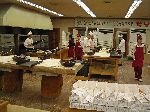
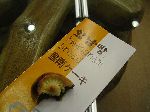 Nighttime is for sweets: This
bakery had a staff of ten on the evening shift and they were selling hwangnam
bread (cookies) hot out of the oven about as fast as they could make them. Hwangnam bread (cookies) are pastry
dough filled with sweet red bean paste. They are a specialty of Gyeongju.
Nighttime is for sweets: This
bakery had a staff of ten on the evening shift and they were selling hwangnam
bread (cookies) hot out of the oven about as fast as they could make them. Hwangnam bread (cookies) are pastry
dough filled with sweet red bean paste. They are a specialty of Gyeongju.
 Please
contact us if you would like to be added to
Ibike's mailing list or have questions, comments, corrections or criticism. (Also, please let us know how you learned about us and
found this site.) Privacy policy.
Please
contact us if you would like to be added to
Ibike's mailing list or have questions, comments, corrections or criticism. (Also, please let us know how you learned about us and
found this site.) Privacy policy.
![]() IBF Homepage
IBF Homepage ![]() Ibike Programs
Ibike Programs
![]() Ibike Schedule
Ibike Schedule
![]() Search
Search



